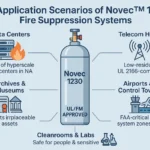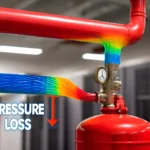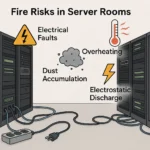Many believe that simply adding more nozzles guarantees proper FM200 coverage—but this is a dangerous misconception. Effective suppression depends on how the agent flows through the space, not just where it’s released. Room geometry, ceiling height, and obstructions like racks or cable trays significantly influence agent dispersion.
Proper jet dynamics design involves selecting the right nozzle orifice, spray angle, pipe diameter, and layout to meet NFPA 2001 requirements. In one case, a data center system failed to suppress a fire promptly due to poor nozzle placement around overhead obstructions—despite meeting pressure specs on paper.
Jet dynamics isn’t optional—it’s essential for system reliability when it matters most.
Common Pitfalls in FM200 System Design
A frequent and costly mistake in FM200 system design is assuming that more nozzles automatically ensure better coverage. This misconception overlooks key aspects of agent behavior governed by jet dynamics. In practice, the effectiveness of FM200 depends not on nozzle count, but on achieving uniform agent concentration throughout the protected space within the NFPA 2001-mandated 10-second discharge window.
Overreliance on nozzle density—without accounting for spray pattern geometry, flow rate, discharge pressure, and obstruction mapping—can lead to dead zones, over-saturation, or delayed agent mixing. These conditions compromise total flooding effectiveness and can cause a system to fail compliance with Section 5.4 of NFPA 2001.
We’ve observed installations, particularly in high-density storage rooms or underfloor data centers, where symmetric nozzle placement failed due to unaccounted airflow from CRAC units or obstructions like cable trays. These real-world oversights can result in nozzle chatter, pressure imbalances, or uneven velocity across discharge points—even when the system meets baseline pressure specs on paper.
Proper coverage isn’t about quantity—it’s about engineered flow. Without precise flow calculations and layout-specific discharge modeling, adding more hardware only increases cost without improving performance.
Engineering Precision in Jet Dynamics: Methods and Modeling
Precision in FM200 system design starts with engineering the discharge dynamics around the specific characteristics of the protected space. Key parameters—such as nozzle orifice diameter, spray angle, pipe diameter, pipe length, and layout geometry—must be calculated based on room volume, ceiling height, and the spatial distribution of obstructions, including cable trays, columns, or server racks.
Accurate flow modeling is essential to ensure agent dispersion meets the NFPA 2001-mandated minimum design concentration within the 10-second discharge window. This requires simulating the system’s transient jet field and pressure wave propagation during initial discharge. Failure to do so can lead to agent pooling, cold spots, or incomplete suppression coverage—especially in high-ceiling or compartmentalized environments.
Computational Fluid Dynamics (CFD) modeling tools such as Fire Dynamics Simulator (FDS) or ANSYS Fluent allow engineers to visualize and quantify agent distribution, velocity gradients, and obstruction interference before installation. These simulations also support compliance with NFPA 2001 Annex C by validating nozzle flow rates, coverage factors, and discharge timelines under site-specific boundary conditions.
In mission-critical environments like data centers, battery storage rooms, or control facilities, reliance on default layouts or vendor-supplied charts is no longer sufficient. Each FM200 system must undergo design-stage verification of flow behavior using CFD or equivalent hydraulic modeling. No system should proceed to procurement or commissioning without a documented flow validation that confirms uniform coverage and identifies potential dead zones.
Jet dynamics in FM200 systems is not just a design detail—it’s the foundation of effective fire suppression. When engineered correctly, it ensures agent concentration, delivery timing, and spatial coverage all meet mission-critical standards. When neglected, it introduces risks that cannot be mitigated post-installation.
At Flarenix, we specialize in precision-engineered FM200 suppression solutions tailored to the complexities of real-world environments. Our design process integrates CFD modeling, NFPA 2001 compliance validation, and application-specific hardware to deliver performance you can trust—before the system is even deployed.
Whether you’re designing for a single-room deployment or a multi-zone facility, we’re here to support your team with technical guidance, engineered systems, and installation-ready kits built to exacting standards.
Let’s eliminate uncertainty from your suppression design—contact Flarenix today for expert consultation or to request a system design review.




